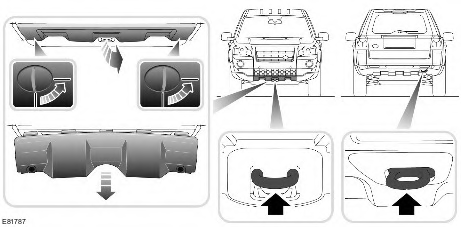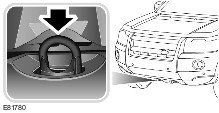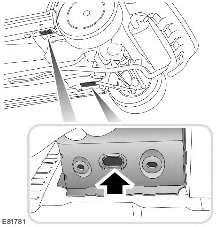Range Rover Evoque: Vehicle Recovery
Towing Points
 CAUTION: The
single towing points at the front and rear of the vehicle are designed for
vehicle recovery purposes
only and must NOT be used to tow a trailer or caravan.
CAUTION: The
single towing points at the front and rear of the vehicle are designed for
vehicle recovery purposes
only and must NOT be used to tow a trailer or caravan.

The front towing eye is accessible after releasing the 2 toggle fasteners securing the towing eye access panel and removing the panel.
 CAUTION:
Ensure that during towing, the towing attachment does not contact the bumper.
CAUTION:
Ensure that during towing, the towing attachment does not contact the bumper.
The rear towing eye is accessible after releasing the 2 toggle fasteners securing the towing eye access panel and removing the panel.
 CAUTION:
This towing eye should only be used for towing another vehicle or for recovery
purposes.
CAUTION:
This towing eye should only be used for towing another vehicle or for recovery
purposes.
Towing the vehicle on four wheels
 WARNINGS:
WARNINGS:
Ensure that the remote control remains docked whilst the vehicle is being towed. Removing the remote control will engage the steering lock, which will prevent the vehicle from steering correctly.
If the engine cannot be run whilst the vehicle is being towed, there will be no power assistance for the steering or brakes. This will result in greater effort being required to steer or slow the vehicle, and greatly increased stopping distances.
 CAUTIONS:
CAUTIONS:
The vehicle should only be towed with four wheels on the ground. Towing with two wheels on the ground will result in serious damage to the transmission.
The vehicle should only be towed for a maximum of 80 km (50 miles), at a maximum speed of 80 km/h (50 mph).
Towing for a greater distance, or at a higher speed may result in serious damage to the transmission.
 NOTE: The
recommended recovery method is to raise all four wheels.
NOTE: The
recommended recovery method is to raise all four wheels.
Towing procedure
1. The vehicle should be parked on firm level ground, with the park brake on, and the gear selector in P if an automatic gearbox is fitted.
2. Secure the towing attachment from the recovery vehicle to the front towing eye.
 CAUTION:
Leaving the ignition switched on for extended periods will cause the battery to
drain.
CAUTION:
Leaving the ignition switched on for extended periods will cause the battery to
drain.
3. Dock the remote control, and switch on the ignition.
4. Apply the foot brake, and select neutral.
5. With the footbrake still applied, release the park brake.
6. The vehicle can now be towed a maximum of 80 km (50 miles) at a maximum speed of 80 km/h (50 mph).
7. Upon arrival at the destination, ensure wherever possible that the vehicle is parked on firm level ground.
8. Apply the park brake, and place the selector lever into the P position.
9. Switch off the ignition, and remove the remote control.
 WARNING: Use
extreme caution when detaching towing equipment. Vehicle movement is possible
which can result in
serious injuries.
WARNING: Use
extreme caution when detaching towing equipment. Vehicle movement is possible
which can result in
serious injuries.
10. Remove the towing attachment from the towing eye.
Lashing Points
 WARNINGS:
WARNINGS:
Use the lashing points at the front and rear of the vehicle, DO NOT secure lashing hooks or restraints to any other part of the vehicle.
The front and rear lashing points must only be used for securing the vehicle during transportation.


The grahics show the front and rear lashing points.
Transporting by trailer
 CAUTION: Use
the lashing points at the front and rear of the vehicle, DO NOT secure lashing
hooks or restraints to
any other part of the vehicle.
CAUTION: Use
the lashing points at the front and rear of the vehicle, DO NOT secure lashing
hooks or restraints to
any other part of the vehicle.
Position the vehicle, apply the parking brake and select 'N' - Neutral. The recommended method for recovery/transportation of the vehicle, is on a transporter or trailer designed for that purpose.

